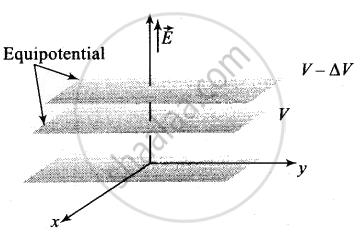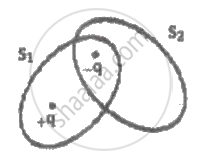Advertisements
Advertisements
Question
Consider a uniform electric field in the ẑ direction. The potential is a constant ______.
- in all space.
- for any x for a given z.
- for any y for a given z.
- on the x-y plane for a given z.
Options
a, b and c
a, c and d
b, c and d
c and d
Solution
b, c and d
Explanation:
We know, the electric field intensity E and electric potential V are E = `- (dV)/(dr)`
Electric potential decreases in the direction of the electric field. The direction of electric field is always perpendicular to one equipotential surface maintained at the high electrostatic potential to another equipotential surface maintained at low electrostatic potential.

The electric field in the z-direction suggests that equipotential surfaces are in the x-y plane. Therefore the potential is a constant for any x for a given z, for any y for a given z and on the x-y plane for a given z.
APPEARS IN
RELATED QUESTIONS
A regular hexagon of side 10 cm has a charge 5 µC at each of its vertices. Calculate the potential at the centre of the hexagon.
What is the geometrical shape of equipotential surfaces due to a single isolated charge?
Answer the following question.
Two identical point charges, q each, are kept 2m apart in the air. A third point charge Q of unknown magnitude and sign is placed on the line joining the charges such that the system remains in equilibrium. Find the position and nature of Q.
Statement - 1: For practical purpose, the earth is used as a reference at zero potential in electrical circuits.
Statement - 2: The electrical potential of a sphere of radius R with charge Q uniformly distributed on the surface is given by `Q/(4piepsilon_0R)`.
S1 and S2 are the two imaginary surfaces enclosing the charges +q and -q as shown. The electric flux through S1 and S2 are respectively ______.

Equipotentials at a great distance from a collection of charges whose total sum is not zero are approximately.
- The potential at all the points on an equipotential surface is same.
- Equipotential surfaces never intersect each other.
- Work done in moving a charge from one point to other on an equipotential surface is zero.
What is meant by an equipotential surface?
